Subjects
Farm
Search
Archives
Farm Articles

Upgrade from boggy waterhole to trough
Posted in Farm on Thursday 31st October 2019 at 4:25pm
One of our fields has several springs in it which we have collected and now use for our drinking water which is delivered around the houses, buildings and water troughs on the farm by our hydram. We have always used the overflow from the collection tank to allow our cattle to drink water in the corner of this field. We felt it was time to fit a water trough in this field now which ensures a plentiful supply of clean water for the cattle but also reduces any erosion of the soil around the stream and silt run off from cattle paddling around the soggy area.

Change of Policy
Posted in Farm on Sunday 29th September 2019 at 6:47pm
Age catches up with us all and we have decided to move away from breeding cows to keeping store cattle. With a very much reduced number of cows and calves this year we have been buying different breeds of store cattle to see what suits the farm and climate and us. We have ended up with some Ruby Reds, Aberdeen Angus, British Blue and Hereford Friesian crosses. It will be an interesting new phase in our farming life.
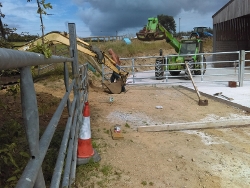
Phase 4+
Posted in Farm on Thursday 18th July 2019 at 5:28pm
We are at last on the final phase of our building project at Old Walls that we started back in 2005. We have been steadily replacing our old 1940’s buildings and making the yard fit for purpose and compliant with regulations set by DEFRA.
We now have a covered cattle yard and isolation box with protected drive in feed passage, a drive in workshop to enable machines to be mended day and night in wet, dry, hot or cold weather conditions with washing facilities, a shed to store winter bedding and machinery and finally a concreted yard around the buildings to avoid muddy conditions in winter to avoid soil erosion. Maybe as we approach the official retirement age we can finally stop building and laying concrete and enjoy the ease of the workplace we have created!

Hedgerows
Posted in Farm on Sunday 2nd June 2019 at 11:11am
The photo, some might say, is uninteresting or just “green” but look below the surface and there is a wealth of interesting plants, habitats and history. The majority of our boundaries are Devon banks, a double stone-faced bank with a hedge growing up from the middle. These Devon banks/hedges are very important as wildlife habitats as they are species-rich in flowering plants, insects, birds and mammals. From the name of our farm, Old Walls, it is also obvious that they have historic value too in agriculture for livestock containment, livestock shelter from wind, control of soil erosion and surface runoff. They also provide timber when they have been layed after many years of growth without trimming. As a casual observer I have noted Blackthorn, Hawthorn, Gorse, Hazel, Ash, Holly, brambles, wild strawberries, violets, dandelions, docks, stitchwort, celandines, ferns, bluebells, foxgloves, red campion … this list goes on and I haven’t even started on the birds, bugs and mammals!

Time for some maintenance
Posted in Farm on Wednesday 29th May 2019 at 12:01pm
Over the years on many occasions we have spent time digging out black thorns or bramble prickles from our arms and hands after working with our hedgerows ,on our Devon banks, around the farm. Many years ago, Miles even had to resort to having the surgeon take some black thorns out or his arm! Laying hedges and replacing rotten or broken fence posts are some of the worst jobs. Joy of joy we now have a mechanical post driver which can insert and drive home replacement fence posts. This has two advantages. Firstly, no prickles to dig out and secondly, we can put the posts in without having to resort to cutting back the overhanging bushes before work starts. We win and the environment wins too.

Water for all
Posted in Farm on Monday 1st April 2019 at 9:27pm
The new hydram is working well delivering a plentiful supply of water to our reservoir. But it became time to check all the water troughs on the farm in readiness for the grazing season. Suckler cows can drink gallons of water each day especially when it is hot and they are producing litres of milk for their suckling calf. If a trough is damaged a leak can empty a field trough very quickly. They then push it around trying to get at the fresh water that is managing to fill it again and that can damage the pipes serving the trough and lead to an even bigger leak. We found one of our very old large metal troughs, which was providing water to 2 fields, leaking and in need of replacement. We decided to put a new concrete trough in each field giving a dedicated supply to each field. Each is a heavier trough so if the water did become low it makes it less likely to be moved by thirsty cows!

The 10th and final year of free walks
Posted in Farm on Saturday 9th March 2019 at 5:40pm
Back in 2010 we signed into a Higher Level Stewardship agreement with Natural England which enabled us to provide up to 25 free guided walks a year. Over the years we have had many, many people including 3 year olds from our local pre-school and more mature folk up to 93! We have delivered varied and diverse content relevant to the groups visiting us including several primary schools, blind GCSE students, engineering degree students, prospective hydro developers, environmental students, art students, U3A groups, family groups, members of the Dartmoor Society, Dartmoor National Park, Dartmoor Preservation Association, WI, Natural History Society, Devon Wildlife Trust, groups interested in green energy schemes for their communities and many more. We are looking forward to welcoming another 25 groups this year, bookings are already being confirmed – will you be with one of them?

The human cost of TB
Posted in Farm on Monday 11th February 2019 at 6:01pm
Having just come in from the farm, peeled off several layers of clothes including waterproofs, hat, gloves and body warmer and plunged my hands in to tepid water (which felt like boiling) my hands have come alive enough to type. We have just completed our TB readings. TB tests are a gut-wrenching job that all cattle farmers have to do. The first day is injection day with the vet identifying each animal, shaving the injection site, measuring the skin in each of the 2 sites and then injecting them with 2 different solutions under the skin. The stress for the animals, especially the older cows who know what’s coming is hard to watch and can make them difficult to handle. Then the awful wait of 3 days before the vet visits again. This time he just needs to measure the skin on the injection sites to see if there is a reaction ie a lump. With each animal your heart is in your mouth wondering if this animal is destined to be slaughtered before her time because of a high TB skin reading. At the end of our test this year we are clear. It leaves you with a bitter sweet feeling – yippee we are clear for another year but oh lord we will have to go through this all again in a year or sooner if one of our farming neighbours “goes down” with TB. Time for a very hot cup of tea and let the nervous energy of the morning dissipate.

Our cattle's health
Posted in Farm on Sunday 9th December 2018 at 12:27pm
Recently there has been a lot of interest in reducing the use of antibiotics in farm animals and people. Each one of us is responsible for using these drugs properly to ensure maximum benefit to us and our animals and to all who follow by ensuring they don’t lose their effectiveness. One way that we have reduced the need for antibiotics is to keep our herd as healthy as possible by prevention. We do this mainly by homeopathic treatments. Our herd can be easily treated in their drinking water to prevent diseases such as mastitis, BVD, silage eye, Johnes disease, Leptospirosis, IBR, pneumonia, joint ill, red water, lice, ringworm and black leg. Homeopathic treatment is used the world over especially in organic farming and has been available in the UK since 1796. What a pity our own “powers that be” will not let us join their “Healthy Livestock” initiative unless we follow a narrow minded western medical path. Using a combination of both conventional and homeopathic treatments is surely the best way forward?

Sustainable water supply
Posted in Farm on Wednesday 21st November 2018 at 11:10am
One of the lasting memories for the Fursdon family during the 1960’s was of watching the old bungalow burning down. The fire brigade could not reach the building due to the narrow lane leading to the farm and with only a limited supply of drinking water available the family was unable to do much to prevent the total loss of the building. At the time of the fire Old Walls had a small hydraulic ram pump that provided all the fresh water directly to the farm and house but after more than 50 years of service the pipe work rusted out and we started using an electric pump. Since then we have installed a big water reservoir in our top field and fitted a water pump and hose by the house. It has always been Miles’s intention to reinstate the Hydram, using a bigger version, as the most sustainable way to transport water up hill to our reservoir tank in our highest field to keep it full all the time ready for domestic, farm or fire-fighting uses. As I write this the new Hydraulic ram pump system is being flushed out ready to start ensuring a constant supply of water directly from our own spring.

From New to Vintage
Posted in Farm on Tuesday 25th September 2018 at 11:16am
On 28th May 1948 Miles’s father registered the Field Marshall, Series 2, Mark 1 for the road, it was brand new. On 30th July 2018 after 8 months in the workshop the newly restored Field Marshall, now 60 years old, has been paraded for the vintage tractor enthusiasts to view at a couple of local shows. Our own very local show is Widecombe Fair which was on 11th September this year. Miles joined the parade of vintage tractors and implements in the main ring showing the visitors the progression through the ages of hay making equipment. Our Field Marshall was pulling a trailed Bamford mower (note the tower of Widecombe Church in the background also known as The Cathedral of the Moor).
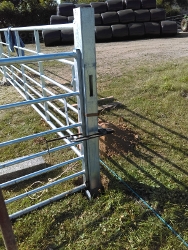
Creating a new boundary
Posted in Farm on Wednesday 4th July 2018 at 12:28pm
During this hot weather the work has to go on but the planning behind it is geared up to ensure we make best use of the cool in the early morning and late evening. Stock work tends to be done late in the evening so the cattle can cool down after being handled and remain cool for a restful night. Unlike harvest work which must happen during the heat of the day the heavier outside manual work that is under our control can be done in the cool of the early morning. Digging post holes by hand on rocky Dartmoor ground is never easy so setting up a new perimeter around our big bales and storage area Miles set himself a target of one gate a morning before breakfast. He is well pleased with the result and has been able to continue in the workshop for the rest of the day without overheating.

The reality of farming
Posted in Farm on Saturday 26th May 2018 at 6:48pm
Before starting my farming life, I was given some very sage advice, “Where there is livestock there will be deadstock – be prepared”. It came home to roost this month when we had to take the decision to have our faithful and productive commercial cow euthanised on the farm as she had become badly affected with arthritis and we were not prepared to put her in a trailer to transport her. She had been with us well over a decade, had produce a fine calf every year and found a place in our hearts. She liked nothing better than having a tickle with a big comb or just your fingers and would move around to show you just where she had an itch– as being demonstrated by our grandchildren in the photo. She was gentle, trusted humans and adored the attention. She has and will be greatly missed – farmers are softies but realists as well.
Photo by Sand in my pocket

Weather vagaries
Posted in Farm on Monday 26th March 2018 at 12:22pm
What a month March has been. We arrive home from abroad 30 hours late at the beginning of the month to freezing temperatures and heavy snow, like much of the UK. Then came the floods as the rain thawed the snow in double quick time. A week of showers and soggy ground followed which has necessitated our cattle staying in the sheds for longer than normal as they would have poached the ground to a muddy puddle. Luckily, we have enough winter food and bedding straw to see us through. Another bout of heavy snow saw us trapped on the moor for a few more days and today 26th March has seen the last of the drifts melt away in the sunshine! With more snow showers forecast for the hills over the Easter weekend you have to wonder what April will bring. Anyone for tea on the patio?
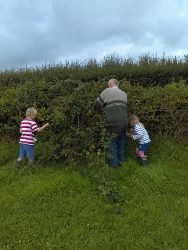
Time to take enjoyment from the farm
Posted in Farm on Monday 28th August 2017 at 11:07am
The second cut silage is cut, turned, baled and wrapped which finishes the harvest for this year. In between cleaning all the harvest equipment up and lightly oiling it before storing it for the winter there is time to enjoy the free harvest from the farm and teach the future generations what fun it can be to pick the fruit in the afternoon and eat it in the evening. This picture is showing our grandchildren leaning about blackberries and they tell me the crumble they had for supper was delicious. During the year we make use of sloes for sloe gin, elderberry flowers for cordial and elderberries for jam, crab apples for jelly to go with pork, hips for rosehip syrup, haws for a fruit butter and rowan berries make a beautifully coloured jam. We also have gooseberries growing wild in our hedges on the farm for pies and wild strawberries to eat as soon as you find them!

Farm assured produce
Posted in Farm on Friday 28th July 2017 at 4:03pm
One of the office jobs that is on-going is keeping records of almost everything we do on the farm. I have recently been inspected so all our cattle can be sold with the Farm Assured tag. You will know this as the Red Tractor Logo that you find on British products in the shops. To achieve this status we have to show accurate, up to date, quantitive, identifiable and comprehensive records on:- emergency plans and procedures; staff and labour providers eg training undertaken; traceability eg ear tags and assurance status of animals bought; vermin control, how, what, where etc; housing, shelter and handling facilities are well kept, large enough and suitable for the livestock kept; feed and water, adequate and suitable; animal health and welfare including an annual herd health plan, records of any treatments and plans for emergencies; bucket reared calves are provided for as they have specific needs; biosecurity and disease control needs a written policy which is carried out in the real world, animal medicines and husbandry procedures are recorded accurately and undertaken by suitably qualified stockmen; fallen (dead) stock are dealt with in a timely manner effectively and efficiently; livestock transport must be adequate in size kept clean; environmental protections and contamination control carried out by certified operators, plans kept and records updated regularly. Whoever said cattle farming was all about “working outside in the fresh air” has never farmed!

New crop of calves
Posted in Farm on Thursday 1st June 2017 at 12:33pm
Only calving a dozen cows this year for us seemed to be a breeze until it started for real. The first calf arrived over a week late but was fine. The second followed a day later and was to keep 5 of us busy for several hours. A new heifer coming into the herd was trying her best but once examined by us and then the vet the decision to “take the calf out sideways” was made. The caesarean was done by 2 vets whilst the cow stands secured by a halter and kept as still as possible by husband and son. Nearly an hour after the first anaesthetic injection a healthy bull calf emerged into the world. My job starts now acting as mum, cleaning the calf up and encouraging him breath and then to stand. Yet another hour later and the stitching on the “15 inch zip” is completed up the side of mama and the calf is ready to suckle. The next 5 calves have been a mixture of “do it yourself” and “help pull” with the calving tool. All arrived alive and are thriving now which is the main objective. Only 3 to go…

Harvest
Posted in Farm on Wednesday 31st May 2017 at 12:52pm
Under our HLS agreement we can start cutting our silage fields on 1st June, in an ideal world we would have started already to make use of the beautiful weather we have been having but Natural England works by the calendar, not nature, when prescribing stewardship schemes. Our workshop has been busy while the boys are mending, maintaining and making ready all the harvest equipment including mower, turner, baler and bale wrapper. The tractor and handler get a good pressure wash after all the winter work to remove all the dung that accumulates over the months of winter yard work. The weather forecast for the 1st June is rain so we will have to wait a little longer before he harvest begins.
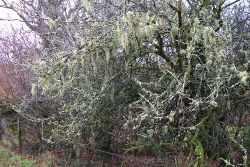
Lichen
Posted in Farm on Wednesday 15th February 2017 at 11:38am
Lichens are a close partnership between a fungus and an alga which is interwoven to appear as a single individual organism. They come in many and varied forms. The picture shows a good example of beard and hair lichens in abundance on our trees just below Old Walls house. Lichen absorb water and minerals from rainwater and directly from the atmosphere, over their entire area. Different species grow in more polluted areas, e.g. industrial sites, than grow in our beautifully clean air on Dartmoor. As a general rule the greener the lichen the cleaner the air, the more yellow varieties the more polluted the air. One interesting fact about lichen is that the litmus dye used so widely as an acid/alkaline indicator in chemistry comes from lichens.

Brashing
Posted in Farm on Monday 30th January 2017 at 12:54pm
After 20 years of growing, with only the first few years being tended, the new wood we planted is ripe for brashing. Technically this means “Removal of the lower dead branches, up to about two metres, of trees in a stand”. From the picture, you can see sky through the trees to our grazing field above. This half of the wood was brashed last winter. We are about to start on the other half nearest our intake. It’s hard heavy work all done on a 45% angle, hence doing it over 2 years. Hopefully it will allow the native bluebells, orchids and violets to flourish and it also allows us the pleasure of being able to walk upright in amongst the trees.

It all takes a very long time...
Posted in Farm on Thursday 29th December 2016 at 4:14pm
Last year on 19th January I posted a picture of our bucket fed baby calves. A year down the road and look how well they have done. They are still as friendly as ever and demand to be tickled, scratched or fed – preferably all three! This summer will see them go to bull and we wait until 2018 for them to calve and yet another year until 2019 when we will eventually be able to sell their calves and finally reap some financial benefit from caring for them and feeding them since November 2015. Cattle farming on the hills is a very long term venture.
Happy New Year!

Thinking towards winter
Posted in Farm on Friday 26th August 2016 at 12:49pm
The corn harvest is continuing apace up country in the arable areas of the south of England. This is where our straw comes from to bed our cattle down during the winter months. We bring it in as soon as possible after harvest to avoid any of the straw getting wet in the outside stacks that are awaiting lorries to transport them to cattle country. Miles brings ours in as he is a relief driver for the local H&M Retallick haulage firm. We can only get the lorry close to the buildings at Old Walls when the fields are dry enough to drive the lorry and drag on. This year has not been a problem as we have had very little rain and on a nice sunny day it becomes a family day. You can see the lorry and drag in the field next to our buildings with North Tor on Spitchwick Common in the background.

Silage hold up!
Posted in Farm on Monday 27th June 2016 at 11:04am
We expect to cut, wilt and bale our 1st silage crop of the year in June. This year we were on track but had a temporary hold up due to a fawn. Our lovely long cutting grass is the perfect place for Row deer to hide their fawns. We suspected that this may have happened as we watch out for our resident doe and had spied her a couple of times in Lower Mills Close before we went to cut it. Miles managed to spot the fawn before he cut the headland and was able to move it into the long grass in the middle of the field in the hope that when he came back to cut the centre of the field the hind would have moved the fawn to another safer field, which indeed was the case. Mean while we were able to take the photo with my had in shot to show how small these animals are and how difficult to spot when mowing.

King of the Castle
Posted in Farm on Thursday 5th May 2016 at 1:26pm
When the sun shines even the calves want to play traditional games but cannot decide who really is “The King of the Castle”.

2 whole days dry!
Posted in Farm on Wednesday 17th February 2016 at 7:18am
What a frantic couple of days Miles and Luke have had. We have just experienced 2 whole days of dry weather this winter. This enabled urgent tractor work to be undertaken on the farms between dawn and dusk and every other daylight minute, even meals were taken in shifts to keep the tractors moving before the rain came again. Dung which has been accumulating during the winter from scraping out the feed channels in the cattle sheds was finally loaded up in the muck spreader and spread lightly on the fields which will be used for growing grass for the silage crop in June. This is a good natural source of nutrients. The other important job was hedge trimming. Under our HLS we are severely restricted on when we can trim hedges – only during January and February. This has proved particularly difficult over the last few flood ridden years as you cannot take the tractors on sodden soil – it damages the soil structure which has long term productivity issues. Roll on the spring!

Baby calves
Posted in Farm on Tuesday 19th January 2016 at 11:58am
To keep our herd productive and invigorated we have to replace some of our “old girls” from time to time. We have found that the best way is to buy baby calves and bucket rear them ourselves. This enables us to buy the right cross breed, for us that is Hereford Friesian cross, who turn into great mothers and cope well with our wet, windy and cold climate at 1000ft. This autumn we bought 3 and the corresponding number of old cows will be fattened and sold during the summer months. Rearing the calves on our farm also gives them the chance to develop immunity to the bugs and bacteria on our farm. They adjust to the mineral and trace element levels present in our soils, and therefore grass, before they become mothers themselves for the first time at about two and a half years old.

Flood 6 Water Water Everywhere ...
Posted in Farm on Thursday 31st December 2015 at 6:51pm
Once again we have experienced the power of nature with the quantity of rain dropped on Dartmoor in a very short space of time. We watched the garden flood in just 30 minutes and a lake appear in one of our cutting fields. Our daughter’s garden disappeared under water too. As the rain flowed off the road, across our field through a hedge into Olands garden, down past the chicken coop, down again across our lawn and into the woods, it is hard to see how much more as farmers we can do as the Environment Agency and politicians are suggesting.

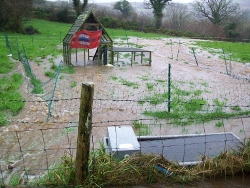
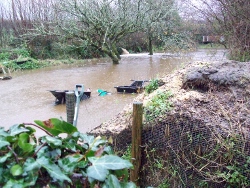



New additions
Posted in Farm on Sunday 27th September 2015 at 9:27pm
To help our self sufficiency along we have added a couple of chickens to our livestock list. They have such quirky characters and entertain us each evening while they have their hour of freedom in the garden. We have too many foxes about to allow them unrestricted freedom and plenty of cover in the woodland for the predators to wait their opportunity. With just the two of us at home it serves us very well with enough deep yellow yolked eggs each week to bake a big sponge, have some boiled eggs in our lunch time salads and enough left over for an omelette supper each week. Sorted!

Wild flora
Posted in Farm on Monday 31st August 2015 at 7:49pm
As the autumn advances and the days become cooler and damper it gives the opportunity for new growth. In one of our “species rich” fields, that Natural England identified, we have an old tree stump decorated with a colony of fungi. This field is treated according to our Higher Level Stewardship prescriptions – no fertilizer what so ever, no lime, no spraying, no harrowing and much more. For the reduction in farm production in this field we get compensated through our HLS and the unusual flora benefits.

Time to continue the building
Posted in Farm on Sunday 26th July 2015 at 5:04pm
At last the urgency of calving and silage harvest is over and we can organise our time as we see fit rather than the cows or the grass dictating what we do and when! Obviously we still need to be mindful of what the elements can throw at us, like today with heavy rain and gusting winds. Luckily a few days ago the weather was fair and the ground dry enough to do some more work on our farm buildings which needed a track to the straw barn dug out to give a gentle curve around the building as well as a safe gradient. Miles has efficiently dealt with the topsoil, subsoil and the ever present Dartmoor granite. All that has been dug out has been gainfully used around the farm in other places. For example the subsoil then topsoil has been used on other fields to level out areas to enable then to be machine friendly or to increase the depth of topsoil where it is thin. Recycle, re-use as ever is our motto.

Winter jobs
Posted in Farm on Wednesday 31st December 2014 at 6:57pm
The obvious jobs are the daily task of feeding silage to the cows, scraping the yards of slurry, spreading new straw on the cattle beds and breaking ice on the water troughs. During this time we also check the cattle over to make sure they are healthy with no foot problems from being on concrete floors or eye problems like silage eye. In January we will treat all the adult cattle for liver fluke and later with a mineral supplement bolus to counter the low levels of copper, cobalt and selenium and various other trace elements on our farm. Towards the end of winter we will wean the cows to give them a rest before they calve again in spring. With the short amount of daylight to work in outside and long dark nights it is time to start the workshop jobs in earnest; servicing all the machines in our new workshop, mending and creating new pieces of kit to make our work easier or more efficient. When the weather and soil conditions are right the tractors are fired up for dung spreading or hedge trimming (we are only allowed to cut hedges between 1st Jan and 28 Feb). This is just a small sample of what needs to be done and I haven’t even mentioned the office work. This time of year is often referred to as the quiet time of year – I have yet to work out why!
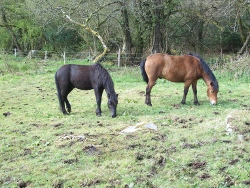
The Dartmoor Pony year
Posted in Farm on Wednesday 21st May 2014 at 12:26pm
As well as the work we do with the cattle we also keep Dartmoor ponies. The Dartmoor pony year is dominated by checking the ponies on the open common daily. We drift the ponies off in the autumn over 2 days with all the other commoners, sort them out and bring ours home to wean their foals and worm the mares if necessary. If any of the mares are looking in poor condition they stay on the farm until they are well enough to return to the common. The foals are kept on the farm until we can find a buyer for them, they are used as conservation grazers, they are old enough to return to the common as part of our herd or as a last resort we sell them to the zoo for lion meat. If we are keeping them we have them chipped, inspected and passported as heritage Dartmoor ponies. The colts are gelded by the vet when they are about a year old. With our stallion we maintain a herd of 28 on Spitchwick Common.
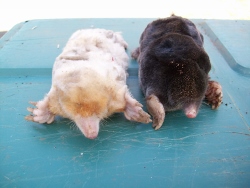
Future planning
Posted in Farm on Tuesday 1st April 2014 at 12:13pm
We are at the time of year when we have to start thinking about the future and all the things we need to prepare for. Uppermost in our minds at the moment is the field work. We need to harrow and roll all the fields we are laying up to cut for silage and hay later in the summer. This has to be done when the ground is moist enough to roll flat but dry enough not to leave tractor wheel ruts so when we come to cut the grass we keep soil out of the grass mixture to be made into big bale silage. One of the many pests we have to deal with are moles. They love the moist soil beneath grass as it contains so many worms but the mole hills they leave behind can contaminate our grass silage and one mole hill can rot one big bale of silage. The answer is to catch the moles in the spring thus eliminating the mole hills. This year we have been successful with our catching programme but also surprised by catching, for the first time, a white mole. Rare but not unheard of.

Replacement farm buildings
Posted in Farm on Monday 30th December 2013 at 7:29pm
A well earned rest and cuppa for Miles and Luke who have spent many many hours over the last couple of years building our new 5 bay barn. This has replaced our range of 1940’s buildings which were really on their “last legs” and not fit for purpose anymore. At last the barn is weather proof with roof, block wall bases and boarding or Yorkshire boarding for the walls. We had to have help laying the 30 cubic meters of ready mixed concrete and for the electrical fixtures but this like all our projects is truly home built with the families hard graft. It will be a joy to use this winter and many more to come!

Food for free
Posted in Farm on Wednesday 14th August 2013 at 1:09pm
What a difference in the weather and for us a huge difference is what we can do and when we can harvest. One of the joys of walking around the farm in the summer months has always been the wonderful surprises of the hedgerows. This year I have already picked a glorious crop of gooseberries, wild strawberries, sloes and raspberries. I am now looking forward to the blackberry crop which is looking good for jam, wine and good old fashioned crumble for pudding. We will also benefit from elderberries for jam, rosehips for syrup, crab apples for jelly sauce and hazelnuts to crunch later in the year. Money cannot buy the joy of harvesting food for free!
Pay day
Posted in Farm on Saturday 27th July 2013 at 8:39pm
Payday comes but once a year for us from the cattle. Each year we calve our cows in spring and the cows suckle their calves for 10 months – hence the name Suckler cows. These calves are then weaned and when winter finishes, which was very late this year, they go into the fields to eat nutritious young spring grass. When they are 15 or 16 months old and are looking really healthy having lost their shaggy winter coats and are growing well we take them to Newton Abbot Market and sell them for other farmers to fatten them. It is an exciting day but also nerve wracking as the price we receive will depend on who is looking for cattle that day and what price they are willing to pay at the auction.

Sunshine!
Posted in Farm on Wednesday 24th April 2013 at 4:32pm
What a joy having a few hours of sunshine is, it lifts the spirit and work pace! The lack of sunshine last summer has had a lasting effect on our cows. We would normally expect to be 75% through calving by now but we have only had 25% of our cows calve so far this spring. Having checked the feed, mineral supplements and health of our cattle I pondered what could be the cause of so many cows calving late. Sunshine is the answer or lack thereof! Last year when the bull came to visit it rained for the first 4 weeks he was with our cows, he and they huddled under hedges to shelter from the worst effects of the heavy downpours with never a thought to “getting together” to mate and make this years crop of calves arrive on time! Time will tell if my projection is right, that we will be busier than usual with calving cows the first week in May (2013) following a glorious week of sunshine in late July last year (2012) – 9 months ago!
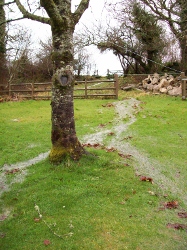
Paperwork deadlines in the rain!
Posted in Farm on Monday 31st December 2012 at 12:23pm
As I watch the Cherry tree divert the flood waters around it in our garden I have to wonder if it will survive this constant soaking of its roots or drown! The farm fields are not much better with pools and small lakes appearing after heavy rain where grass should be. Much time is being spent by farmers around the country filling in their Soil Protection Review, deadline 31-12-12, to satisfy the powers that be that we are aware of waterlogged soils and are able to show how we will treat them! We have to identify each field by its number, describe its soil type, the use of the land, soil issues eg run off carrying lots of silt, do a risk assessment on the soil and identify measures to be taken if the soil has issues - that's just to mention a few of the items to be addressed. This is just one of the many forms, assessments, surveys and registers we have to keep for the government.

Hay and silage harvest complete
Posted in Farm on Saturday 25th August 2012 at 1:39pm
With the rain falling yet again it is with a thankful heart that we can at last say our harvest is over. The last of the big bale silage was wrapped this morning before the heavens opened. We have managed to make enough silage for the winter period and have some small bale hay which gives us some flexibility when feeding small groups of cattle in the autumn, the odd sick animal or if we get caught with snow this winter we can carry a small bale on our backs to stranded animals. Big bales are easily moved as long as you can use a tractor not always the case in heavy snow or very icy conditions!

Silage and showers
Posted in Farm on Monday 2nd July 2012 at 1:28pm
What a month June has been, busy, busy, busy! We have been trying to dodge the rain and showers to make some silage for the cows winter fodder and conducting tours for WWT in between. We are about a month late with our harvest and the feed value of the crop slowly drops as the days go past, while the crop continues to bulk up. The lower feeding value needs to be reviewed as the winter goes along to make sure we are not under feeding our cows nutritionally while still “filling their tums” with the bulk. Our cows are still milking during the winter suckling their calves, so the nutrition needs to be correct or health problems start manifesting themselves. We work a family system with silage with Miles cutting and big baling, anyone who’s spare turns and strolls the grass, our son helps out bringing the bales in and Gail wraps the bales in the black cling film leaving Miles to stack then in our clamp ready for winter use. Intense long days but we are steadily winning against the weather!

Jobs for the spring
Posted in Farm on Wednesday 23rd May 2012 at 12:15pm
The timely arrival of the rain followed by some warmer weather has enabled our grass to get growing at a rate that allowed us to put all our cattle out onto the pastures. The cattle barns are being mucked out and the silage fields left un-grazed for the grass crop to grow on until there is enough tonnage of grass to cut it and turn it into our big bale silage – for next winters fed rations. It is clear that the cattle are contented now with the sun on their backs and the calves well fed, it’s time for a well earned rest. Corndon Tor makes a wonderful back drop! Some of the other jobs for the spring include, disbudding and castrating the calves, protecting the cows from flies with a pour-on fly repellent, clean out the cattle sheds and spread the dung, spot spray the injurious weeds e.g. docks, nettles, thistles and ragwort (this is part of the cross compliance rules we have to meet) and catch up on the paper work applying for cattle passports etc. One worrying job for this week is our cattle’s TB test.

Orchard creation
Posted in Farm on Monday 7th May 2012 at 1:40pm
Under our Higher Level Stewardship on the farm we have planted a small new section of orchard which includes cider apple, plum and cherry trees. Our newly planted orchard is just showing signs that the trees have rooted in well with the cherry trees are already producing small leaves. The young apple trees have just been pruned to encourage them to bush out rather than shoot up, the stoned fruit trees will be pruned in the summer. All are now protected from our wild deer with suitable fencing around each tree, this also means we can graze the field around the new trees with our cattle and Dartmoor heritage ponies without worrying that the trees will be eaten!

Contented mother and daughter
Posted in Farm on Wednesday 25th April 2012 at 6:16pm
Evidence of one of the pleasures of farming – seeing a new born calf, just 12 hours old, safely cuddled up to its mum. We are still calving our cows inside due to the ferocious weather we have had over the last few days. The older calves born in the early part of the month are now going out by day into a lush grass field to “kick up their heels”; their mum’s are enjoying the sweet new season’s grass too.

New life on the farm
Posted in Farm on Tuesday 10th April 2012 at 5:03pm
Despite the glorious weather we had through March we are still feeding our suckler cow’s winter rations. The grass has been slow to grow from lack of rain and warmth – although our days have been warm the nights have produced heavy frosts and have kept the soil temperature down. The cows have travelled back to the barns at Old Walls to be closer to home as they are due to calve through April and May. To date we have 4 new calves, all arrived without assistance and are doing well. With the change in the weather over the Easter weekend all the cattle were glad of some shelter from the howling winds and lashing rain.